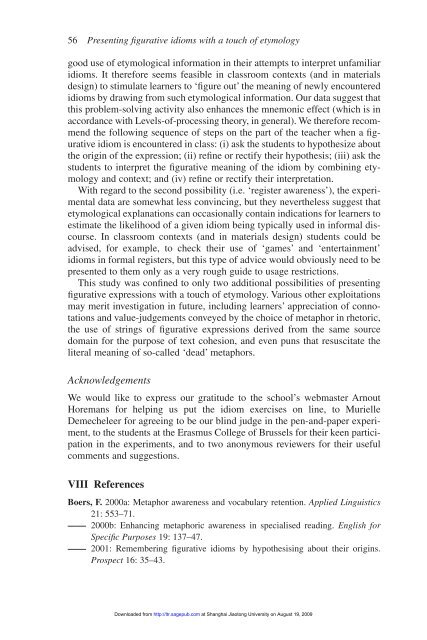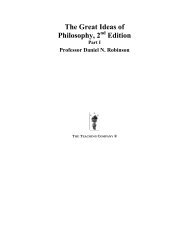Language Teaching Research
Language Teaching Research
Language Teaching Research
You also want an ePaper? Increase the reach of your titles
YUMPU automatically turns print PDFs into web optimized ePapers that Google loves.
56 Presenting figurative idioms with a touch of etymology<br />
good use of etymological information in their attempts to interpret unfamiliar<br />
idioms. It therefore seems feasible in classroom contexts (and in materials<br />
design) to stimulate learners to ‘figure out’ the meaning of newly encountered<br />
idioms by drawing from such etymological information. Our data suggest that<br />
this problem-solving activity also enhances the mnemonic effect (which is in<br />
accordance with Levels-of-processing theory, in general). We therefore recommend<br />
the following sequence of steps on the part of the teacher when a figurative<br />
idiom is encountered in class: (i) ask the students to hypothesize about<br />
the origin of the expression; (ii) refine or rectify their hypothesis; (iii) ask the<br />
students to interpret the figurative meaning of the idiom by combining etymology<br />
and context; and (iv) refine or rectify their interpretation.<br />
With regard to the second possibility (i.e. ‘register awareness’), the experimental<br />
data are somewhat less convincing, but they nevertheless suggest that<br />
etymological explanations can occasionally contain indications for learners to<br />
estimate the likelihood of a given idiom being typically used in informal discourse.<br />
In classroom contexts (and in materials design) students could be<br />
advised, for example, to check their use of ‘games’ and ‘entertainment’<br />
idioms in formal registers, but this type of advice would obviously need to be<br />
presented to them only as a very rough guide to usage restrictions.<br />
This study was confined to only two additional possibilities of presenting<br />
figurative expressions with a touch of etymology. Various other exploitations<br />
may merit investigation in future, including learners’ appreciation of connotations<br />
and value-judgements conveyed by the choice of metaphor in rhetoric,<br />
the use of strings of figurative expressions derived from the same source<br />
domain for the purpose of text cohesion, and even puns that resuscitate the<br />
literal meaning of so-called ‘dead’ metaphors.<br />
Acknowledgements<br />
We would like to express our gratitude to the school’s webmaster Arnout<br />
Horemans for helping us put the idiom exercises on line, to Murielle<br />
Demecheleer for agreeing to be our blind judge in the pen-and-paper experiment,<br />
to the students at the Erasmus College of Brussels for their keen participation<br />
in the experiments, and to two anonymous reviewers for their useful<br />
comments and suggestions.<br />
VIII References<br />
Boers, F. 2000a: Metaphor awareness and vocabulary retention. Applied Linguistics<br />
21: 553–71.<br />
—— 2000b: Enhancing metaphoric awareness in specialised reading. English for<br />
Specific Purposes 19: 137–47.<br />
—— 2001: Remembering figurative idioms by hypothesising about their origins.<br />
Prospect 16: 35–43.<br />
Downloaded from<br />
http://ltr.sagepub.com at Shanghai Jiaotong University on August 19, 2009














